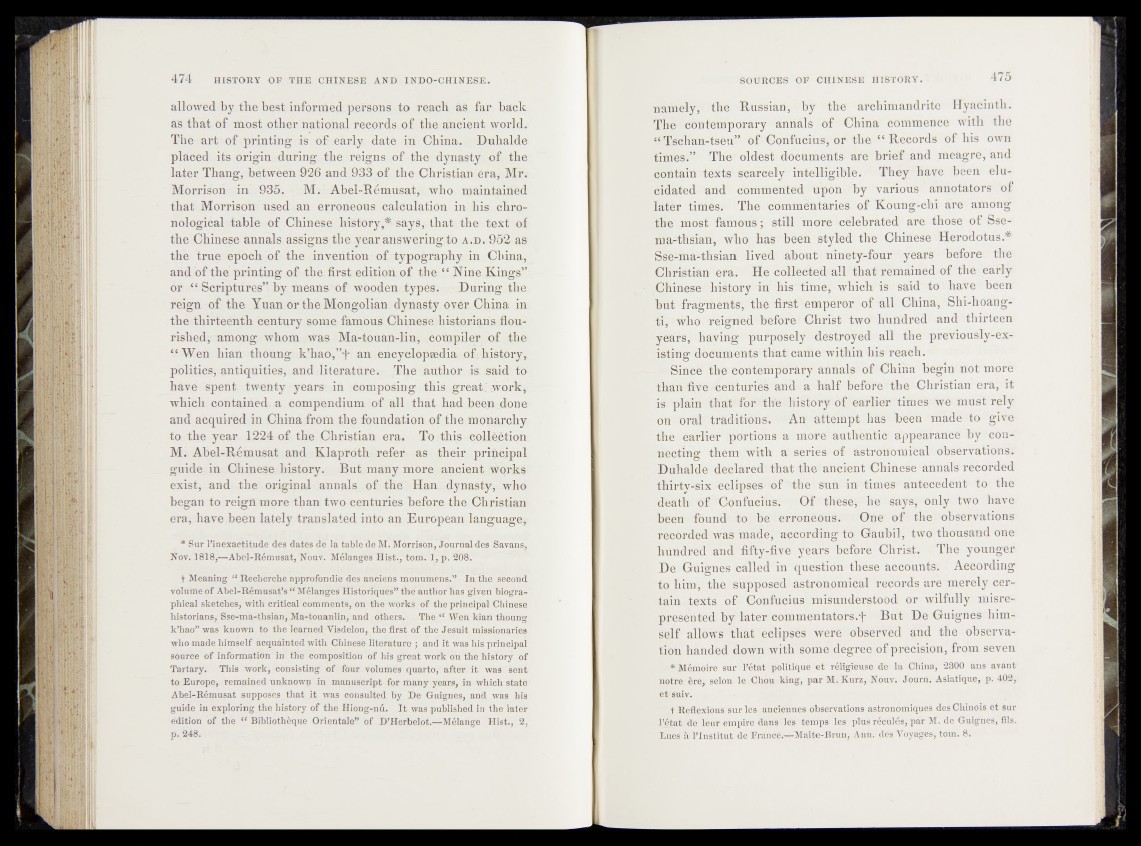
allowed-by the best.informedpersons to reach &â far back
as that of most other national records of the ancient ^.orld..
The art of printing is «öfi early date in China. ' Duhalde,
placed its originduring. the reigns- of-the dynasty, of the;
later Thang, between 926 and 933 of the Christian; era, Mr.-
Morrisoii in 935. M. AbeL-Rem-usat, who maintained
that Morrison used an erroneous calculation in his chronological
table of Chinese history,*- says, that 4he text of
the Chinese annals assigns theyear answering to A.n^9i$S?'as‘
thé true.%poeh of/the . invention of typography in <phinaA
and of the printing of the. first edition of the “ Nine Kings?
or “ Scriptures’Vby. meansof wooden typés, r . ;Durkig thfe
reign of the Yuan or the Mongolian dynasty Qvei*.China- in
the thirteenth century Jsome famous Chinese diiatoKialissttiirip
rished^*among whom was Ma-touan-linr, ^compiler of the
“ Wen hian thoung k’hao,”! an encyclopædia^of ; history,,
politics, antiquities, and literature«- 4The author is .said to
have spent twenty years in composing thiÿigi^atitwdrk,
which contained, a compendium of "all that had beéntdonfe
and acquired in China from the foundation of the monarchy
to the year 1224 o f the.Christian era. To thi^.nçelîection
M. Abel-Rcmusat and Klaproth refer as their principal
guide in . Chinese history. But many mor^vaneient w'qrks
exist, and the original annals of the" Han^dlynasty^ who
began to reigfl more than two centuries before the Christian
era, have been lately translated into an European, language^
* Sur l’inexactitude des dates de la table de M. Morrisçm, Journal des Savans,
Nov. 1818,—Abtel-Rémusat, Nouv. Méïapges Hist., tom. 1, p. 2Ó8.
t Meaning “Recherche approfondie des anciens monumens.” In thé second
volume of Abel-Rémusat’s “ Mélanges Historiques” the author has given biographical
sketches, with critical comments, on the works of the principal Chinese
historians, Sse-ma-thsian, Ma-touanlin, and cithers. The “ Wen kian thoung
k’hao” was known to the learned Visdelou, the first of the Jesuit missionaries
who made himself acquainted with Chinese literature ; and it was his principal
source of information in the composition of his great work oil the history of
Tartary. This work, consisting of four volumes quarto, after it was sent
to Europe, remained unknown in manuscript for many years, in which state
Abel-Rémusat supposes that it was consulted by De Guignes, and was his
guide in exploring Jhb tistory of the Hiong-nû. It was published in the later
edition of the “ Bibliothèque Orientale” of D’Herbelot.—Mélange Hist., 2,
pi. 248.
namely,'!“'the Russian, /fey the archimandrite Hyacinth.
TM'' (fô'ntempcirârÿ annals b f 1'Chin« commence with the
£|TsChan-tse'u” of/CônfucméJ oj the “ Records of his own
times.iV The^pldêst d^cumChtS* are brief and meagre, and
i^É;îâm‘'texts<.‘SCàl:fe]iy1> intelligible. • They have been elucidated
" and ' ^omment^i^hT^ by various annotators of
la%er "fBaaésn? Tfe'e’commentaries'of Koung^chi are among
the most famous; still mordioblebrated are those of Sse-
ma-th’sian, who has «feèefr stylef’- the Chinese Herodotus.*
^e-ma-thsian kWd" about ninety-four years before the
Christian era. He Collected all that remained of the early
Chinese history in his'&ÉÊf®, which is* said have been
but fragments; the'first''emperor-'':of4 all China, -Shi-hoangi'
ti,> who reighed'heforè* Christ two hundred and thirteen
yéars, h ^ in g 'plarpilsM’y^ destroyed’^ all the previously?*»*
isting docum-àlrts thafècame within his reach.
- Since the contemporary annals uf* China begin not more
than fiyë^centuries and a half before the-’Christian era, it
is- plain tha$tfbr'!fh'e history of earlier time's'we must rely
'•On oral tradition's5.'-* An attempt hds~fbebk madê^to'give
the -- earlier ‘ rportiohs* a-' moi’fi authentic® appè’arancèdly '’connecting
thé me with a séries of astt*anhmfcal observations.
Duhalde declared* that the ancient Chinese »annals recorded
thirty-six eCtipseS of'the'sun in times antecedents to the
death b£ Ckiifueiiis; Of thesis^ he -says,'only two have
been found to he erroneous^ One -of the ^observations
recorded was madej "according to Gauhil, two thousand one
hundred' ànd fifty-five years before’'Christ. The younger
De Guignes called 'in question these accounts. - According
to him, the supposed astronomical records are merely certain
texts of Confucius misunderstood or wilfully misrepresented
by later commentators.! But De Guignes himself
allows that eclipses Were observed and the observation
handed down with/ktime degree of precision, from seven
- * Mémoire sur' Pétât politique et‘ réligieuse de la China, 2800 ans avant
notre- ère,: selon le Chou king, par M. Kurz, Nouv. Journ. Asiatique, p. 402,
et'suiv.
t-.Reflexions sur les anciennes observations astronomiques des Chinois et sur
l’état de leur empire dans les temps les plus réculés, par M. de Guignes, fils.
Lues à l’Institut de Franee.—Malte-Brun, Ann. dés Voyages, tom. 8.